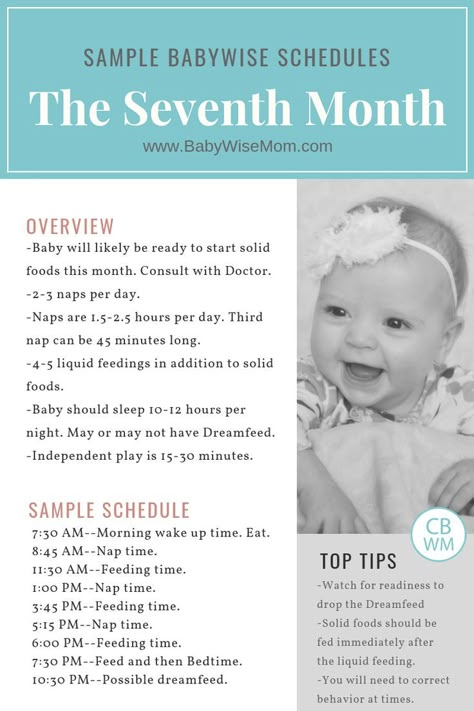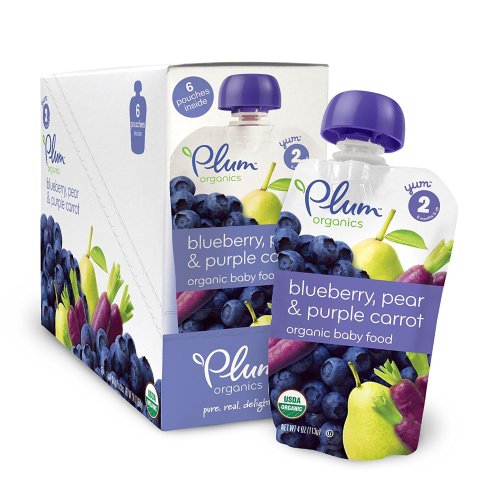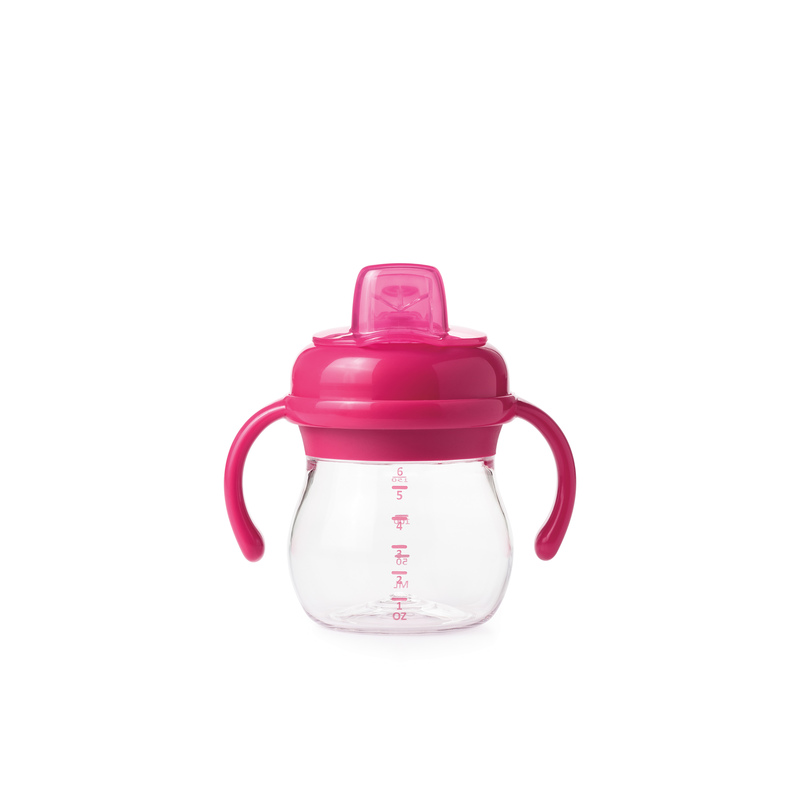Feeding baby cottage cheese
Cottage Cheese for Babies-Can Babies Eat Cottage Cheese?
When can babies eat cottage cheese?
Cottage cheese, if it is low in sodium (less than 100 mg per serving), may be introduced to babies as soon as they are ready to start solids, which is generally around 6 months of age.
Where does cottage cheese come from?
Cottage cheese has roots in the lands connecting Africa, Asia, and Europe, where humans learned how to turn milk into curds and whey in ancient times. As Europeans colonized the Americas, they brought cows and dairy traditions with them. Originally known as farmer’s cheese and queso del país on American farms and homesteads, cottage cheese made use of leftover whey after skimming fatty cream from fresh milk to make butter. Warming this skimmed milk made curds that could be eaten fresh, pressed into forms, or seasoned with cream, whole milk, and salt. This latter method led to the modern cottage cheese that is widely available today.
Is cottage cheese healthy for babies?
Yes, when low in sodium. Homemade cottage cheese, as well as “no salt added” and some “low-sodium” store-bought cottage cheese products, are nutritious additions with plenty of protein, B vitamins including folate, and other vital nutrients like calcium, selenium, iodine, and zinc. Some varieties (sometimes called “cultured cottage cheese”) even add probiotics, which may support gut health, while offering a fuller-bodied, tangier flavor.
When shopping for cottage cheese, look for brands that have less than 100 mg of sodium per serving. Cottage cheese can be exceedingly high in sodium, with some brands exceeding 1,000 mg of sodium per serving. Thankfully, rinsing cottage cheese in a fine-mesh colander under cold water can reduce sodium levels by 60 percent.1
★ Tip: If you’d like to serve fruit with cottage cheese, opt for chopping fresh fruit and mixing it in yourself. While there are store-bought blends of cottage cheese and fruit, these are often very high in added sugar, which is best avoided for babies.
While there are store-bought blends of cottage cheese and fruit, these are often very high in added sugar, which is best avoided for babies.
Is cottage cheese the same as farmer's cheese?
Cottage cheese is a type of farmer’s cheese. There are many types of farmer’s cheese in the world, and they often consist of pressed cheese curds made from cow’s milk. After the curds are removed from whey, they are shaped into a form to further drain moisture from the cheese—similar to how paneer, queso blanco, and queso fresco are made. Consequently, farmer’s cheeses tend to be firmer than cottage cheese, whose curds are often moistened with added cream or whole milk. While they differ in texture, farmer’s cheese and cottage cheese share a similar flavor and they often contain lots of added sodium for taste and preservation.
Is cottage cheese a common choking hazard for babies?
No. Cottage cheese is not a common choking hazard for babies though, in theory, an individual can choke on any food.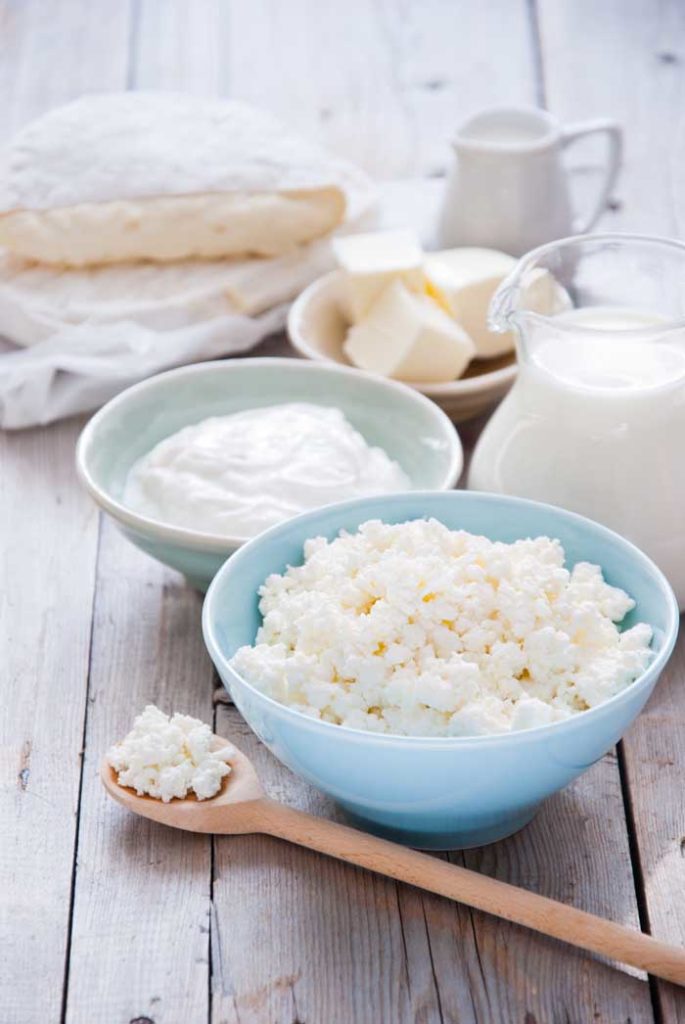 The curds in cottage cheese vary in size and while baby may swallow them whole, the risk of choking is very low if baby is in an upright seat and self-feeding. (Placing food in baby’s mouth increases the risk of choking).2 3 If you feel nervous, you can flatten large curds gently with the back of a fork before serving. As always, make sure you create a safe eating environment and stay within an arm’s reach of baby during meals. For more information on choking, visit our sections on gagging and choking and familiarize yourself with the list of common choking hazards.
The curds in cottage cheese vary in size and while baby may swallow them whole, the risk of choking is very low if baby is in an upright seat and self-feeding. (Placing food in baby’s mouth increases the risk of choking).2 3 If you feel nervous, you can flatten large curds gently with the back of a fork before serving. As always, make sure you create a safe eating environment and stay within an arm’s reach of baby during meals. For more information on choking, visit our sections on gagging and choking and familiarize yourself with the list of common choking hazards.
Is cottage cheese a common allergen?
Yes. Cottage cheese is typically made from cow’s milk, which is a common food allergen in young children, accounting for about one-fifth of all childhood food allergies.4 Keep in mind that dairy products from other ruminants such as sheep, goat, and buffalo may provoke similar allergic reactions to cow’s milk dairy products.5 If baby is allergic to dairy, know that it is an allergy that often disappears with time.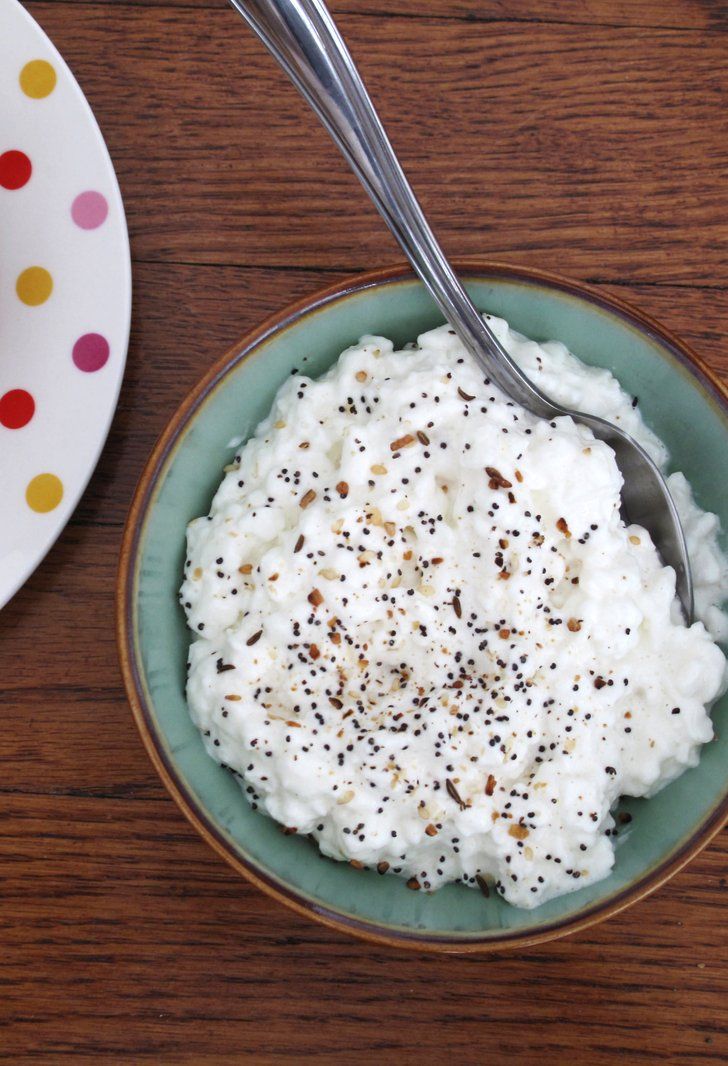 Research shows that the majority of children with cow’s milk allergy will outgrow it by age 6, and many babies with milder symptoms of milk protein allergy (which can show up as painless blood in stool) are able to successfully reintroduce cow’s milk as early as their first birthday, with the guidance of their doctors.6
Research shows that the majority of children with cow’s milk allergy will outgrow it by age 6, and many babies with milder symptoms of milk protein allergy (which can show up as painless blood in stool) are able to successfully reintroduce cow’s milk as early as their first birthday, with the guidance of their doctors.6
Milk is a known cause of food protein-induced enterocolitis syndrome, also known as FPIES. FPIES is a delayed allergy to food protein which causes the sudden onset of repetitive vomiting and diarrhea to begin a few hours after ingestion. Left untreated, the reaction can result in significant dehydration. Thankfully, like other forms of milk allergy, FPIES which presents early in life is generally outgrown by the time the child has reached 3-5 years of age.7 While the exact rates of FPIES are unknown, it is believed to be an uncommon condition (although better recognition of the disease has led to increased reporting in recent years).8
For those with older children who are lactose intolerant (keep in mind this is uncommon for infants and toddlers), cottage cheese is not considered low in lactose.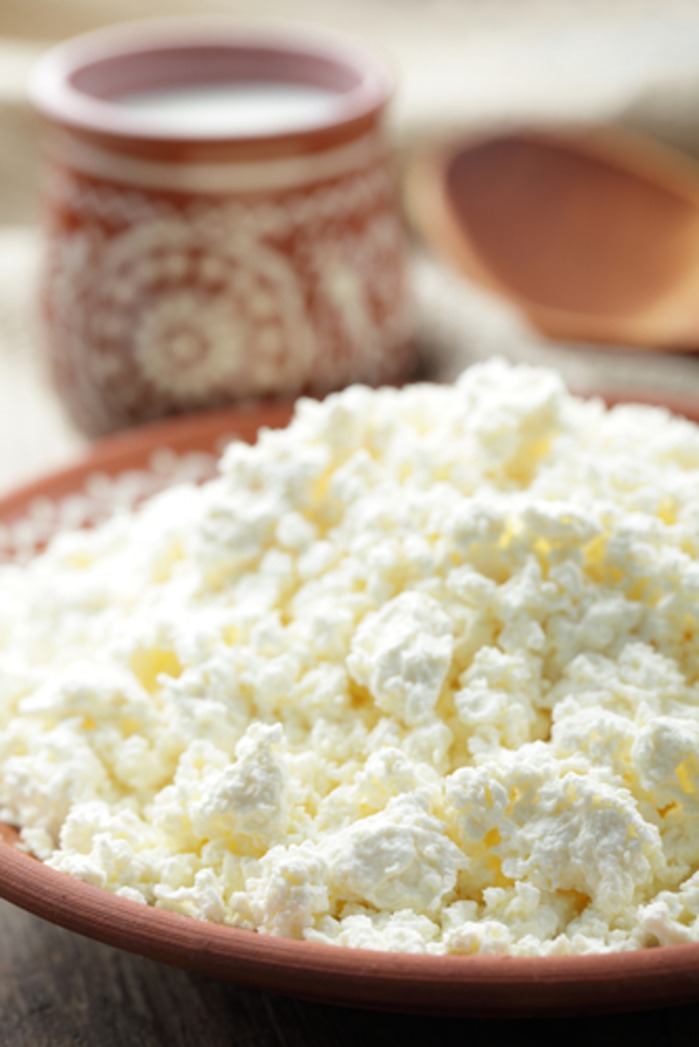 However, there are lactose-free brands available. Note that if your child is lactose-intolerant, it’s important to find calcium-rich foods to consume regularly to ensure a balanced diet and support bone health.
However, there are lactose-free brands available. Note that if your child is lactose-intolerant, it’s important to find calcium-rich foods to consume regularly to ensure a balanced diet and support bone health.
If you suspect baby may be allergic to milk, consult an allergist before introducing dairy products like cheese. Based on baby’s risk factors and history, your allergist may recommend allergy testing, or may instead advise dairy introduction under medical supervision in the office. If the risk is low, you may be advised to go ahead and introduce dairy in the home setting. As with all common allergens, start by serving a small quantity on its own for the first few servings, and if there is no adverse reaction, gradually increase the quantity over future servings.
How do you serve cottage cheese to babies with baby-led weaning?
Every baby develops on their own timeline, and the suggestions on how to cut or prepare particular foods are generalizations for a broad audience.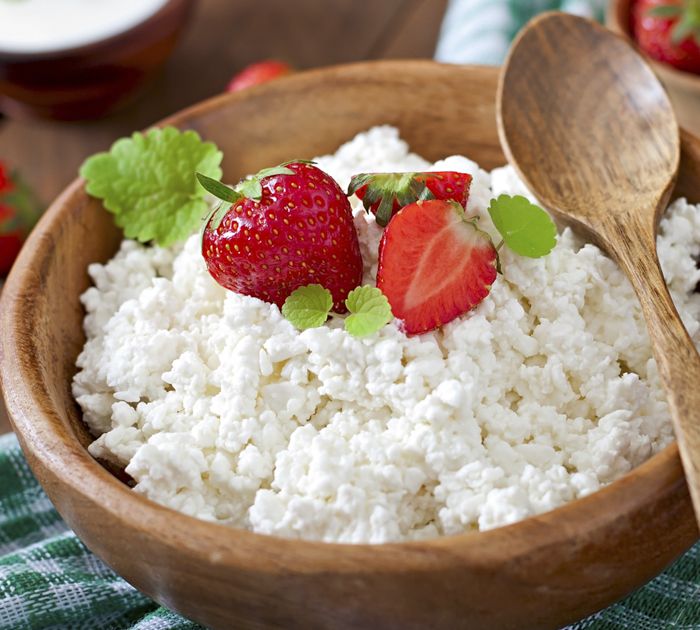 Your child is an individual and may have needs or considerations beyond generally accepted practices. In determining the recommendations for size and shape of foods, we use the best available scientific information regarding gross, fine, and oral motor development to minimize choking risk. The preparation suggestions we offer are for informational purposes only and are not a substitute for child-specific, one-on-one advice from your pediatric medical or health professional or provider. It is impossible to fully eliminate all risk of a baby or child choking on any liquid, puree, or food. We advise you to follow all safety protocols we suggest to create a safe eating environment and to make educated choices for your child regarding their specific needs. Never disregard professional medical advice or delay in seeking it because of something you have read or seen here.
Your child is an individual and may have needs or considerations beyond generally accepted practices. In determining the recommendations for size and shape of foods, we use the best available scientific information regarding gross, fine, and oral motor development to minimize choking risk. The preparation suggestions we offer are for informational purposes only and are not a substitute for child-specific, one-on-one advice from your pediatric medical or health professional or provider. It is impossible to fully eliminate all risk of a baby or child choking on any liquid, puree, or food. We advise you to follow all safety protocols we suggest to create a safe eating environment and to make educated choices for your child regarding their specific needs. Never disregard professional medical advice or delay in seeking it because of something you have read or seen here.
6 to 12 months old: Serve no- or low-sodium (less than 100 mg per serving) plain cottage cheese in a bowl and let baby try to self-feed with their hands. Alternatively, offer cottage cheese mixed into other soft, scoopable foods or spread onto strips of toast. Avoid serving cottage cheese with honey due to the risk of infant botulism, and hold off on store-bought cottage cheese mixed with fruit, due to added sweeteners. Can’t find low sodium cottage cheese? Simply rinse the cottage cheese under water in a fine mesh colander to reduce sodium levels.
Alternatively, offer cottage cheese mixed into other soft, scoopable foods or spread onto strips of toast. Avoid serving cottage cheese with honey due to the risk of infant botulism, and hold off on store-bought cottage cheese mixed with fruit, due to added sweeteners. Can’t find low sodium cottage cheese? Simply rinse the cottage cheese under water in a fine mesh colander to reduce sodium levels.
12 to 24 months old: Continue to offer no- or low-sodium cottage cheese, on its own or paired with savory and sweet foods alike. For toddlers who love cottage cheese, use it as a vehicle to introduce new flavors from herbs and spices. Serve cottage cheese with a small bowl of seasoning on the side, and invite toddlers to flavor the cheese as they see fit. To encourage the use of utensils, pre-load a spoon and pass it in the air for the child to grab, or rest a pre-loaded spoon next to the bowl for toddlers to pick up.
Mix up your mornings with ideas from our guide, 50 Breakfasts for Babies & Toddlers.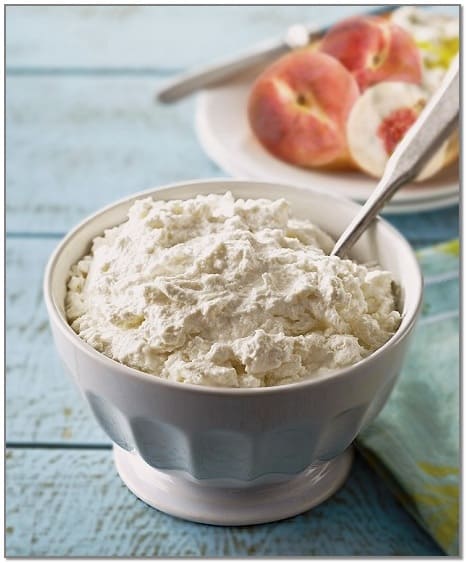
What are recipe ideas for cooking with cottage cheese?
Cottage cheese adds a pop of tangy flavor to cooked vegetables, meatballs, pancakes, pasta sauce, and scrambled eggs. Its creamy, tangy flavor can also stand in for yogurt in baked goods, breakfast bowls, and smoothies. Just like ricotta cheese, you can whip cottage cheese to create a creamy dip to serve alongside broccoli florets, cucumber spears, or sweet potato wedges. And of course, cottage cheese tastes delicious on its own. Try pairing cottage cheese with sweet fruits and add a sprinkle of finely ground nuts or seeds. Keep in mind that the curds in cottage cheese retain their structure when exposed to heat. This texture can be a good thing in frittatas, fritters, and pancakes, but if you prefer a smoother finish, seek out brands of cottage cheese marked “small curd.”
Recipe: Farmer's Lunch
Yield: 1 cup (240 milliliters)
Cook Time: 5 minutes
Age: 6 months+
Ingredients
Farmer’s Lunch is a choose-your-own-adventure kind of meal.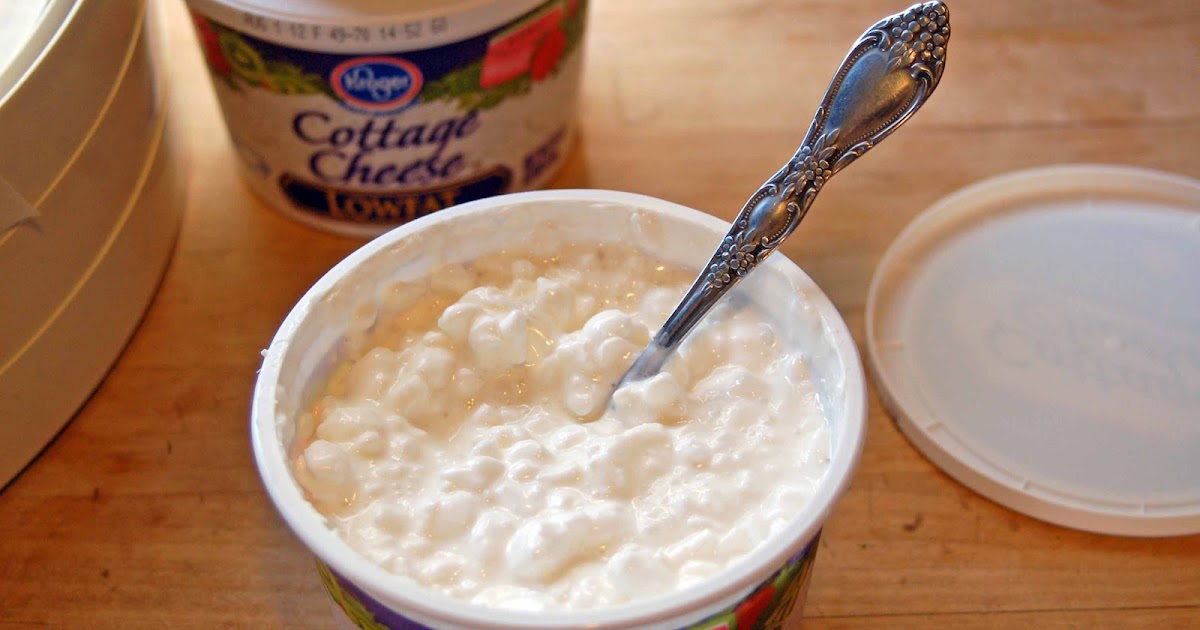 Use whatever fruits and vegetables you like. The goal is a simple lunch that comes together quickly with minimal effort.
Use whatever fruits and vegetables you like. The goal is a simple lunch that comes together quickly with minimal effort.
- 1 slice bread
- ⅓ cup (80 milliliters) cottage cheese
- 1 cucumber
- 1 plum tomato
- ¼ cup (60 milliliters) blueberries
- salt to taste for adults and older children (optional: 12 months+)
This recipe contains common allergens: dairy (cottage cheese) and wheat (bread). Only serve to a child after these allergens have been safely introduced. Always check for potential allergens in ingredients listed on the labels of store-bought processed foods, such as bread and cottage cheese. Added ingredients may include honey, which should not be given to babies under 12 months of age.
Directions
- Toast the bread and then cut the bread into strips about the size of two adult fingers pressed together.
- Spread a thin layer of cottage cheese on baby’s toast strips, then place them on a plate for baby.
 Scoop the rest of the cottage cheese into a bowl for baby.
Scoop the rest of the cottage cheese into a bowl for baby. - Wash the cucumber, tomato, and blueberries. Cut the cucumber into spears and the tomato into large wedges and flatten the blueberries. Place the cucumber and tomato in baby’s bowl and place the flatted blueberries on the side of baby’s bowl for baby to pick up individually.
Serve the Farmer’s Lunch
- Place the bowl and blueberries in front of baby and let baby self-feed. If baby struggles to pick up the food, pass a piece in the air to baby or preload an age-appropriate utensil for baby to grab from you.
To Store: Leftover cottage cheese keeps in an airtight container for 1 week. Leftover cucumber spears, tomato wedges, and blueberries keep in an airtight container for 4 days.
Flavor Pairings
Cottage cheese is both creamy and tangy: a flavor combination that pairs well with corn, egg, quinoa, rice, pasta, and turkey.
Reviewed by
J. Truppi, MS, CNS. Certified Nutrition Specialist®
Truppi, MS, CNS. Certified Nutrition Specialist®
V. Kalami, MNSP, RD, CSP. Board-Certified Pediatric Dietitian and Nutritionist
K. Tatiana Maldonado, MS, CCC-SLP, CBIS, CLEC. Pediatric Feeding Therapist
K. Grenawitzke, OTD, OTR/L, SCFES, IBCLC, CNT. Pediatric Feeding Therapist
Dr. S. Bajowala, MD, FAAAAI. Board-Certified Allergist & Immunologist (allergy section)
Dr. R. Ruiz, MD, FAAP. Board-Certified General Pediatrician & Pediatric Gastroenterologist
- Vermeulen, R. T., Sedor, F. A., & Kimm, S. Y. (1983). Effect of water rinsing on sodium content of selected foods. Journal of the American Dietetic Association, 82(4), 394–396. Retrieved May 16, 2022
- Fangupo, L. J., Heath, A. L. M., Williams, S. M., Erickson Williams, L. W., Morison, B. J., Fleming, E. A., Taylor, B. J., Wheeler, B. J., & Taylor, R. W. (2016). A Baby-Led Approach to Eating Solids and Risk of Choking. PEDIATRICS, 138(4), e20160772.
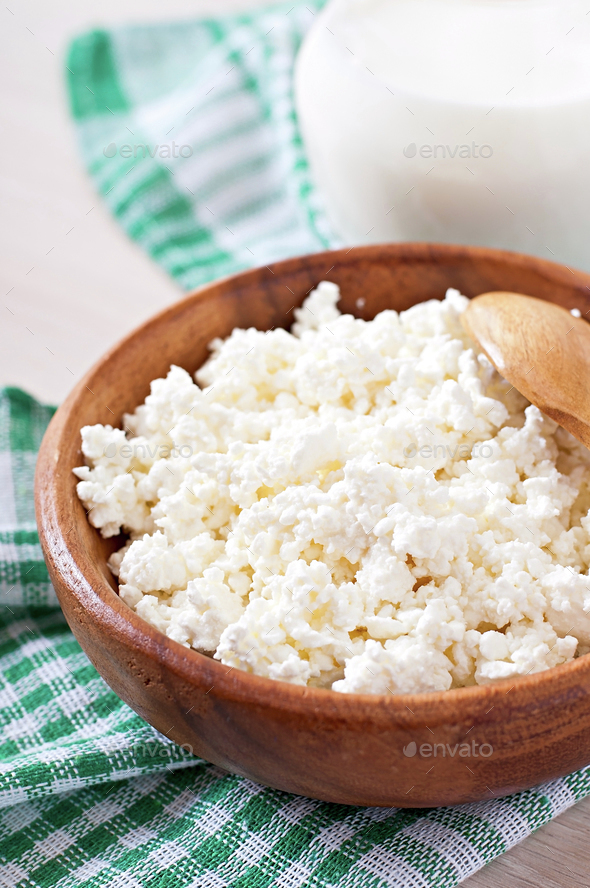 DOI: 10.1542/peds.2016-0772. Retrieved May 16, 2022
DOI: 10.1542/peds.2016-0772. Retrieved May 16, 2022 - Shune, S. E., Moon, J. B., & Goodman, S. S. (2016b). The Effects of Age and Preoral Sensorimotor Cues on Anticipatory Mouth Movement During Swallowing. Journal of Speech, Language, and Hearing Research, 59(2), 195–205. DOI: 10.1044/2015_jslhr-s-15-0138. Retrieved May 16, 2022
- Warren, C.M., Jhaveri, S., Warrier, M.R., Smith, B., Gupta, R.S. (2013). The epidemiology of milk allergy in US children. Ann Allergy Asthma Immunology, 110(5):370-374. DOI:10.1016/j.anai.2013.02.016. Retrieved May 16, 2022
- El-Agamy, E. (2007). The challenge of cow milk protein allergy. Small Ruminant Research, 68, 64-72. DOI: 10.1016/j.smallrumres.2006.09.016. Retrieved May 18, 2022
- Mukkada, V. (2019). Cow’s milk protein allergy. GI Kids. Retrieved May 16, 2022
- Nowak-Węgrzyn A. (2015). Food protein-induced enterocolitis syndrome and allergic proctocolitis. Allergy Asthma Proc. 36(3):172-84.
 doi: 10.2500/aap.2015.36.3811. Retrieved May 16, 2022
doi: 10.2500/aap.2015.36.3811. Retrieved May 16, 2022 - National Organization for Rare Disorders. Food Protein-Induced Enterocolitis Syndrome. Retrieved May 6, 2022
Cottage Cheese for Baby | Feeding Your Baby Cheese and Cottage Cheese Recipes | What Age to Feed Cheese to Baby
Image: Shutterstock
When can baby eat cheese and what kinds of cheese should you offer to baby?
As mentioned in the Dairy FAQ page, cheeses are typically offered to the non-allergic baby between 8 and 10 months of age. If your baby has a known or suspected dairy issue (either a milk protein or lactose intolerance) then you should wait to introduce cheese and other dairy when your infant is older. As always, you should consult baby’s pediatrician about introducing cheese to your baby as generalities may not apply.
Cheese is very good for baby and provides calcium, “good” fats and protein too. You can introduce cheese to your baby by offering the lighter tasting cheeses (Colby, Jack, Mild Cheddar) and also by offering her cottage cheese. Cottage cheese can be a really fun and tasty finger food for babies.
Cottage cheese can be a really fun and tasty finger food for babies.
If baby cannot mash/grasp, melt cheeses over vegetables or add to veggie/meat purees. If baby can mash/grasp and has had Baby Finger Foods, cut cheeses into small bits and offer to baby as a snack.
Cheeses may also be offered to your little one via the old classic grilled cheese sandwich or mac-n-cheese – again, this will be dependent on how baby is with mashing/grasping other foods.
What about Soft Cheeses for Feeding My Baby, Are they Safe?
Cheeses such as Brie, Feta, Camembert, Roquefort, and Bleu Cheese are amongst those called “soft” cheeses. These cheeses are typically not cultured and in many countries, are not made from pasteurized milk; they are made from raw milk. Cream Cheese is not considered a “soft” cheese that you need to avoid because it is pasteurized.
Products made from raw milk may carry a bacteria called listeria. The incidence of listeria in the United States is very low as the vast majority of dairy products sold in the US are either pasteurized or cultured. The “safest” types of cheeses are Cottage cheese, ricotta, cream cheese, processed cheeses and hard cheeses like cheddar and parmesan. As mentioned, cultured dairy products like yogurt are generally considered to be safe for both a baby and a pregnant woman. Check the labels on the cheese products you buy and ensure they are either cultured or made from pasteurized milk products.
The “safest” types of cheeses are Cottage cheese, ricotta, cream cheese, processed cheeses and hard cheeses like cheddar and parmesan. As mentioned, cultured dairy products like yogurt are generally considered to be safe for both a baby and a pregnant woman. Check the labels on the cheese products you buy and ensure they are either cultured or made from pasteurized milk products.
How can I feed my baby cottage cheese; do you have any “recipes” for giving baby cottage cheese?
Cottage cheese is a good choice for dairy if your baby has been OK with yogurt and/or other cheese. The one thing about cottage cheese that you might be mindful of is the texture. For babies just starting out on dairy, cottage cheese might not be a good choice as a first starter due to it not being as highly cultured as yogurt. For those infants who do not have a lot of experience with textures and lumpy foods, cottage cheese may not be a good starter for dairy is due to the texture.
You can puree cottage cheese and mix it with fruits and even veggies if you like. If your baby is doing well with texture and dairy such as yogurt, cottage cheese is one of those foods that makes a nice finger food (albeit a very messy one).
Ideas & Types of Cheese for Feeding to Your BabyTypes of Cheeses: Colby, Cheddar, Monterrey Jack, Parmesan, Romano, Cottage Cheese.
Always buy Cheese from a Deli and ensure you buy full cheese and not a “Cheese food product” such as Velveeta or those packaged cheese slices. While there is nothing terribly wrong with these cheeses, we prefer our babies to have only natural real cheese without any artificial colors or fillers.
Colby, Cheddar, Monterrey Jack, Parmesan, Romano- Shred it and offer is as finger food – it’s cheaper to buy a block and then shred it yourself but you can buy the pre-shredded cheese
- Melt it over baby’s veggies
- Melt it over some toast points, pita bread or any whole grain bread
- Stir it into baby’s rice and noodle dishes
- Add cheese to J&J’s Baby Meatballs
- Scramble egg yolks with shredded cheese for extra nutrition and added Yum.
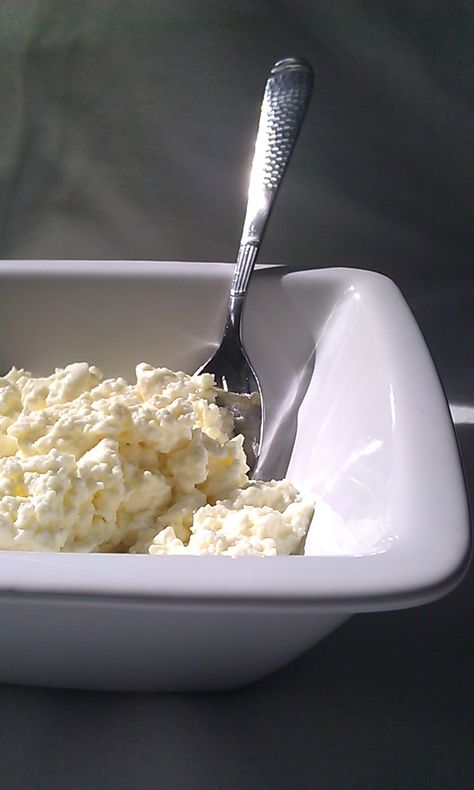
- Grate some cheese over your baby’s meal to entice him to eat
- Cheese mixed and baked into pancakes (most particularly Buckwheat pancakes) is very yummy. Add a veggie to the mix for an extra yummy nutritious Cheesy & Veggie Cake “meal” or snack.
- Mix cottage cheese with your baby’s favorite fruit purée or fruit dices – we still love peachy cottage cheese.
- Spread cottage cheese and fruit purée over toast, a bagel or bread
- Mash cottage cheese and avocado for a healthy “meal” or snack
- Cottage Cheese is yummy when mixed with noodles and some grated cheese for a “quick” Faux lasagna.
- Serve cottage cheese with a pinch of pepper and garlic or a pinch of onion powder and pepper
- Chop some (cooked) veggies and mix with cottage cheese – offer mixed with rice or noodles if you desire
- Blend cottage cheese with lentils and beans
Remember, always consult with your pediatrician regarding introducing solid foods to your baby and specifically discuss any foods that may pose allergy risks for your baby.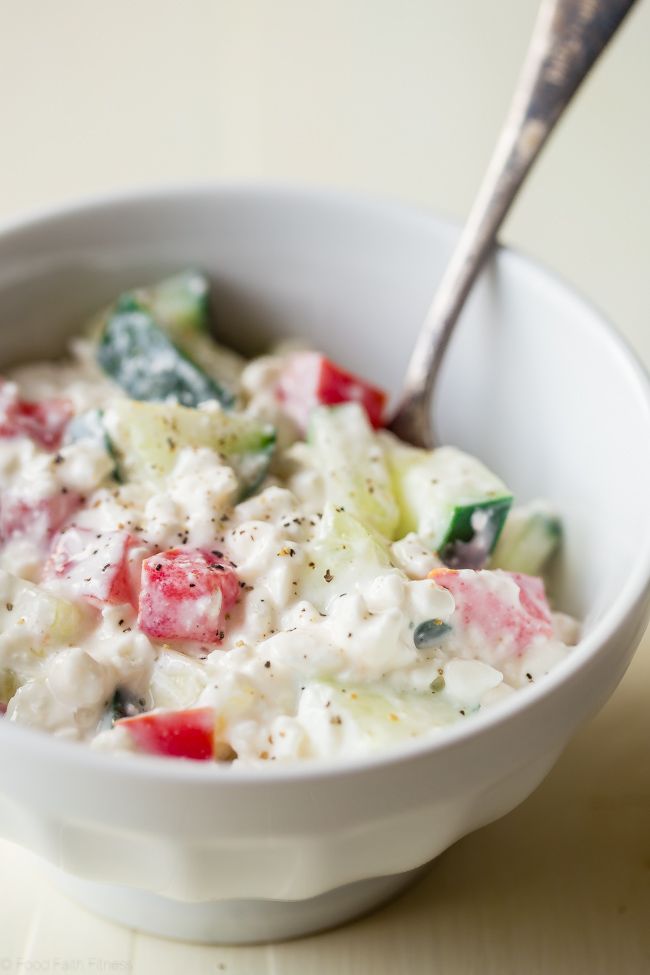
SHARE ON FACEBOOK SHARE ON PINTEREST
Cottage cheese in the diet of a baby up to 1 year old
Complementary foods - solid food that supplements breast milk or powdered milk formula , the nutritional value of which no longer corresponds to the age and needs of the growing body of the baby. Even from a small amount of complementary foods, an infant receives a lot of energy, nutrients and nutrients for full growth and development.
- Alla Anatolyevna, at what time can you give cottage cheese for complementary foods?
— Traditionally, a child is taught to eat cottage cheese in the second half of life. At this stage, the enzymatic system, pancreas, gallbladder, liver, stomach begin to actively perform their functions, and the intestines are sufficiently populated with beneficial microflora, which is indispensable for the digestion of cottage cheese. The ideal time to try cottage cheese and other fermented milk products is 7-8 months.
— What is the use of cottage cheese for a baby?
— Cottage cheese is a nutritious lactic acid product, a key supplier of protein, calcium and phosphorus to the baby's body. It contains B vitamins and folic acid. For motor activity, in order to roll over, sit steadily, stand up, crawl and walk independently, normal physical maturation and proper nutrition are required, including a sufficient intake of trace elements from cottage cheese. Teeth, bone and muscle systems also need to be supported by calcium and phosphorus.
It contains B vitamins and folic acid. For motor activity, in order to roll over, sit steadily, stand up, crawl and walk independently, normal physical maturation and proper nutrition are required, including a sufficient intake of trace elements from cottage cheese. Teeth, bone and muscle systems also need to be supported by calcium and phosphorus.
Important! If you are allergic to cow protein, cottage cheese is prohibited. Only 8% of infants who are allergic to cow's milk protein tolerate goat's milk protein. For them, goat cottage cheese is introduced into complementary foods, which is well absorbed.
- Is goat curd suitable for a child who has eaten goat milk porridge?
- 92% of children with cow's milk protein intolerance cannot tolerate goat's milk protein. But if the baby has already consumed cereals or yogurt with goat's milk and everything was in order, then the likelihood that goat's curd will suit him is very high.
Read also
- about the benefits of goat curd for young children
— What is the best time of day to give cottage cheese?
— Curd acidity is suitable for children's stomach, so it is compatible with other types of complementary foods. Traditionally, cottage cheese is given after an afternoon nap for an afternoon snack - you can offer it to your baby along with fruit puree, cookies, yogurt. Cottage cheese is also useful for breakfast, because protein foods are suitable for feeding until 12 noon.
- Alla Anatolyevna, how to introduce cottage cheese into complementary foods and how much cottage cheese can be given to a child?
— Cottage cheese does not belong to the options for the first complementary foods and appears among the “adult food” of a child with his good health and the absence of hypersensitivity to previous complementary foods — cereal, vegetable, fruit, meat. Between the first spoonful of cottage cheese and the previous version of complementary foods, at least two weeks should pass.
The norm of cottage cheese per day for up to two years is 50 g. With its consistent introduction, the volume of a teaspoon gradually increases to this norm.
— Is it permissible to give cottage cheese to children every day?
- Give the curd at the request of the child, taking into account his nutritional interests and state of health. Daily consumption of cottage cheese is allowed according to the age norm. And if the baby loves cottage cheese, but missed one day, then the next day you can give a double portion.
- Purchased or homemade - which cottage cheese is better for the first feeding?
Delicious cottage cheese can be prepared in the family circle at a convenient time for mom. But not every homemade cottage cheese is suitable for babies.
- Raw material. The fat content of industrial cottage cheese is most often 5.5%, and mother can cook cottage cheese with a higher fat content.
 Purchased and farmed cow or goat milk can have a high percentage of fat, which is not always good for a small child with health problems, such as paratrophy. But cottage cheese can be made from skimmed milk if the mother monitors the weight of the baby and counts calories.
Purchased and farmed cow or goat milk can have a high percentage of fat, which is not always good for a small child with health problems, such as paratrophy. But cottage cheese can be made from skimmed milk if the mother monitors the weight of the baby and counts calories. - Storage. Homemade cottage cheese spoils very quickly: its shelf life is no more than two days when stored in the refrigerator. The shelf life of commercially produced cottage cheese is 10 days.
- Taste. The taste preferences of each child are individual: some children love home-made cottage cheese, others - purchased.
Paratrophy - overweight in newborns and children of the first year of life, resulting from overfeeding.
— Which cottage cheese to give to a child — sour or unleavened?
- Breast milk is insipid, but a child of the second half of life is allowed sour milk. Therefore, both options are acceptable. Sour curd is obtained from sour milk or curdled milk. And if you take unleavened milk and add rennet and a slice of rye bread to it, you get unleavened cottage cheese like ricotta, children also love it.
Sour curd is obtained from sour milk or curdled milk. And if you take unleavened milk and add rennet and a slice of rye bread to it, you get unleavened cottage cheese like ricotta, children also love it.
- Purchased cottage cheese - which one is right for the baby?
- There are curds in their pure form based on cow's milk. They are provided to young parents in the dairy kitchen, but you can buy them yourself. An alternative option is to offer the child goat curd or goat curd fruit puree MAMAKO ® for an afternoon snack or breakfast along with porridge.
— When can a baby be introduced to cottage cheese with berries and fruits?
- A child who receives cottage cheese can eat it with fruit, since he tries cottage cheese from 7-8 months, and fruits and berries earlier - from 6.5-7 months.
— Are there any contraindications for complementary foods with cottage cheese?
— Curd contains many calories and the protein component of cow or goat milk. With intolerance to milk protein, it is better not to try cottage cheese at all. With excess nutrition, excess weight or obesity, it is advisable to limit the cottage cheese in the baby's diet.
With intolerance to milk protein, it is better not to try cottage cheese at all. With excess nutrition, excess weight or obesity, it is advisable to limit the cottage cheese in the baby's diet.
— What symptoms indicate an intolerance to cottage cheese in a child?
- Intolerance to cottage cheese, like intolerance to milk, manifests itself in the form of allergic reactions
An alternative food for infants in this case can be a special split milk formula based on hydrolysates or amino acids. The issue of replacing cottage cheese and treating food allergies should be decided by a doctor.
— Alla Anatolyevna, mothers often ask about the start of complementary foods with fermented milk products on the recommendations of Dr. Komarovsky. Please comment on this position.
- 20-30 years ago, dairy and sour-milk products were really used for the first complementary foods: kefir - from the third month, cottage cheese - from the fourth month.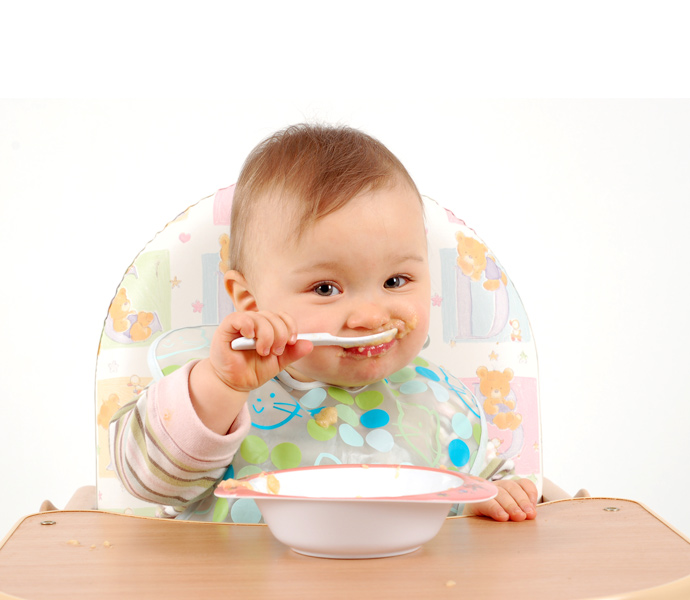 Now WHO does not recommend including them in early complementary foods. Modern pediatricians recommend meat to start protein feeding.
Now WHO does not recommend including them in early complementary foods. Modern pediatricians recommend meat to start protein feeding.
Cottage cheese is a high-protein and nutritious complementary food option in the second half of the first year of life. Mixing cottage cheese with foods your child has already received can help to incorporate cottage cheese into the diet. Try diluting the cottage cheese with your child's favorite puree, or offer him ready-made fruit puree with goat's curd. Such curd complementary foods are suitable for children with digestive disorders and are liked by babies with a selective appetite and developed taste perception.
* Breast milk is the best food for babies. WHO recommends exclusive breastfeeding for the first 6 months of a child's life and continued breastfeeding after complementary foods are introduced until the age of 2 years. Before introducing new products into the baby's diet, you should consult with a specialist. The material is for informational purposes and cannot replace the advice of a healthcare professional.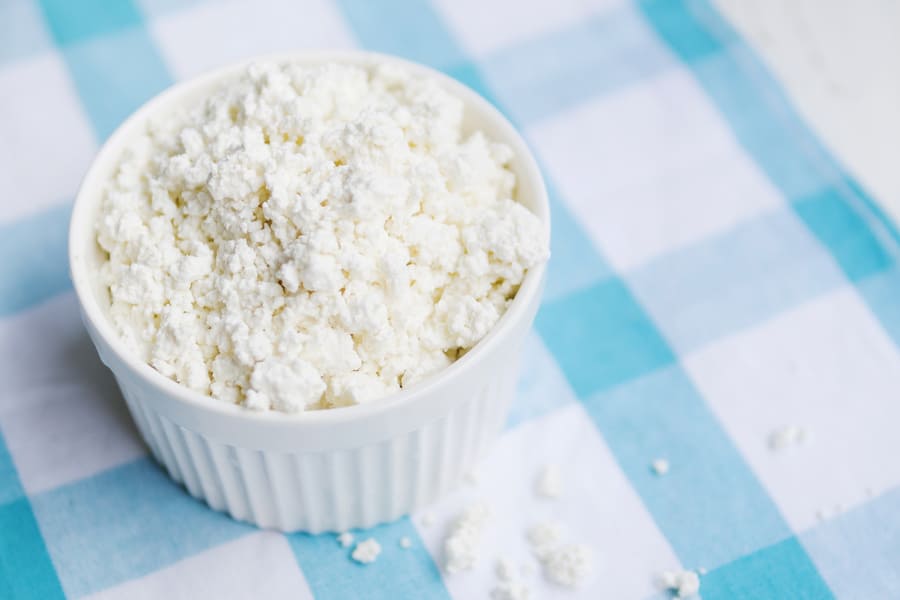 For nutrition of children from 6+ months. The product is certified.
For nutrition of children from 6+ months. The product is certified.
Cottage cheese for children under one year old: from what age, how much and what kind to give
Fetisova Tatyana Gennadievna
pediatrician, neonatologist
Cottage cheese in infant nutrition is always a hot topic on parenting forums. You are not alone if you do not know at what age you can give cottage cheese to a child, which cottage cheese to choose for the first complementary foods, or how much cottage cheese a baby can eat at 6, 8, 9 months. We figure out what's what, in order to avoid unnecessary worries when feeding children.
Useful properties of cottage cheese for a child up to a year
In order for the baby to grow up mobile, sit down and stand up confidently, keep his back straight, have strong bones and teeth, and be calm, it is worth including cottage cheese in his diet. It is rich in easily digestible protein, calcium, phosphorus, B vitamins that support the development of musculoskeletal tissue and the nervous system.
At what age is cottage cheese introduced to children?
When can you give cottage cheese to a baby - a question that can baffle any parent. According to the recommendations of pediatricians and pediatric nutritionists, a healthy child, regardless of the type of feeding, is recommended to introduce cottage cheese no earlier than 8 months . By this time, the main types of complementary foods have already been introduced - cereals, vegetables, meat, fruits. Children's gastrointestinal tract at this age is sufficiently developed to digest and assimilate the first semi-solid food and is ready to accept sour-milk complementary foods.
Of course, each baby develops differently, and not all children try cottage cheese at the age of eight months. This period can be shifted to 6 months, but not earlier and on the advice of your pediatrician.
Tolerability and nutritional efficacy in infants life of fruit and milk purees with goat curd was studied in clinical studies, the results of which confirmed the ability to include them in the diet from 6 months. All children from appetite ate mashed potatoes with goat curd, their introduction is not caused an allergic reaction and had a positive effect on digestion.
All children from appetite ate mashed potatoes with goat curd, their introduction is not caused an allergic reaction and had a positive effect on digestion.
Please note: there is no need to try to feed your baby with cottage cheese, displacing breast or artificial feeding. The main milk supply for up to a year remains breast milk or milk formula - it is necessary that the child continues to drink them in sufficient quantities.
How do you know if your baby tolerates cottage cheese well?
Changes in diet may be accompanied by a temporary change in the color and consistency of the stool. And that's okay. Don't panic if your baby is doing well. After a few days, his body will learn to digest a new product. However, it is important not to lose control of possible adverse reactions.
It could be like this: they ate cottage cheese - their cheeks turned red. Like any other milk product, cottage cheese contains a high concentration of milk proteins. Although they are already partially processed and are easier to tolerate, allergies to them are possible - and this manifests itself individually.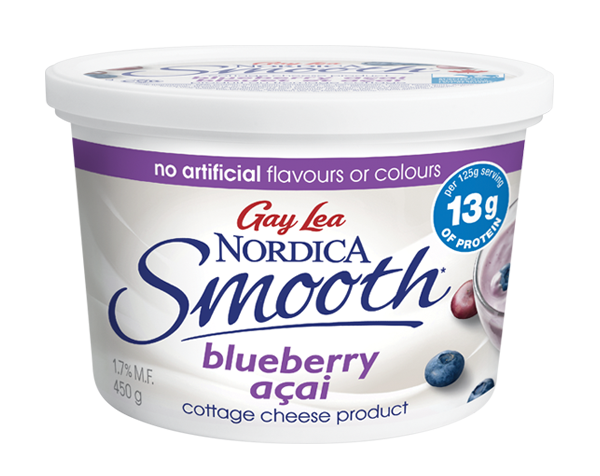
INTRODUCTION SHOULD BE STOP AND REFER TO TO THE DOCTOR IF THE CHILD HAS:
- rash on the face, on the body;
- regurgitation similar to vomiting;
- abdominal pain;
- loose stool or constipation;
- hard belly "drum";
- increased gas formation;
- inclusion of mucus, blood in the stool.
If you are allergic to cow's milk proteins, doctors do not recommend milk supplements. If the child does not have manifestations of allergies, you can give baby food based on goat milk, including goat cheese for children.
Be careful also with intolerance to cottage cheese. Its basis is cow or goat milk, which contains lactose (it is also found in breast milk). If a child has congenital lactase deficiency, in which there is not enough lactase enzyme to digest lactose, he will not be able to consume dairy products.
If a nursing mother uses dairy products in her diet and the child is calm at the same time, he has clean skin and good digestion or baby eats and assimilates well infant formula and milk porridge, then you do not need to give up cottage cheese in food.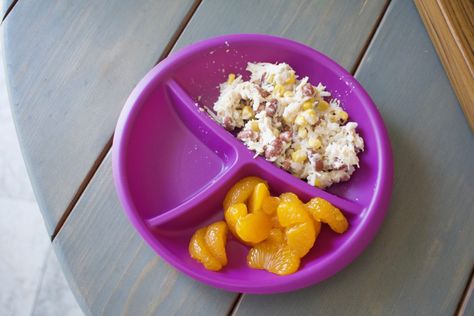 But it is important to introduce it little by little and follow for children's reactions.
But it is important to introduce it little by little and follow for children's reactions.
If the child does not react with restless behavior, skin or gastrointestinal problems to dairy products in the diet of a nursing mother, eats well the mixture, milk porridge, then there is no need to give up cottage cheese in complementary foods. But it is important to introduce it little by little and monitor the child's reaction.
How to introduce cottage cheese into complementary foods for a child?
Proper nutrition helps to set up the digestive tract without failures and without stress on the stomach, intestines, liver, pancreas. In order for a sensitive children's body to better adapt to new food, you should follow simple rules.
- Cottage cheese is administered to a healthy child who is already fully accustomed to complementary foods and tolerates baby cereals and puree well. A new product is not given during the period of vaccination, teething.

- The portion is increased gradually so as not to cause diathesis, indigestion, and not to frighten the baby. Starting with ¼-½ teaspoon, every day, slightly increase the volume, taking into account the interests of the child, noting his reaction to the introduction of cottage cheese. The volume in two weeks is brought to the age norm.
- It is better to offer cottage cheese in the morning before applying to the breast or bottle. A hungry baby, even the most picky one, will agree to have a bite to eat with something new. There will also be time to observe children's sleep, skin and stool, which actually reflect food tolerance.
- It is important to ensure that the product is at room temperature.
Toddlers actively show interest in unfamiliar dishes, studying their taste, texture, smell. But this does not mean at all that the child will eat everything that the mother offers with great pleasure. For him, his own food preferences are the main thing, including in sour-milk complementary foods. If the crumbs liked the cottage cheese, then it can be given every day in an amount not exceeding the daily allowance.
If the crumbs liked the cottage cheese, then it can be given every day in an amount not exceeding the daily allowance.
Daily norms of cottage cheese for children up to a year by months
If a child does not eat cottage cheese, it is not necessary to force him. It is better to postpone acquaintance with the product for a while and try again after a break. When introducing new complementary foods, of course, you need to be persistent, but this must be done gently, affectionately. It can take at least 7-10 days for the taste, color and texture of an unfamiliar dish to be adopted.
If the baby has eaten a spoon and refuses to eat at the next feeding, then you can try to give cottage cheese in a different form, combine it with your baby's favorite foods to create different tastes. For example, cottage cheese with apple or pear puree is a great combination that will appeal to many children. You can mix cottage cheese with vegetable puree, but you should not offer cottage cheese and meat at the same time - calcium and iron interfere with the absorption of each other.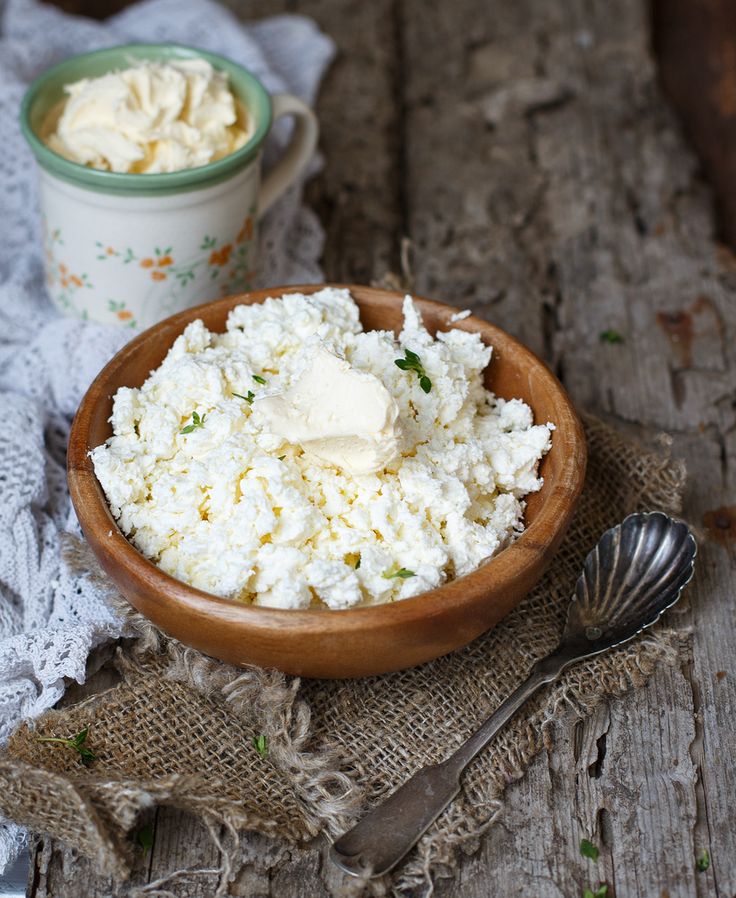 Nuts, candied fruits, raisins, pieces of fruit, root crops should not be added to the first children's cottage cheese: the baby does not know how to chew and swallow them, they can get into the respiratory tract.
Nuts, candied fruits, raisins, pieces of fruit, root crops should not be added to the first children's cottage cheese: the baby does not know how to chew and swallow them, they can get into the respiratory tract.
What cottage cheese to give to a baby?
Proper feeding with cottage cheese meets the following criteria:
- its introduction into the diet is agreed with the pediatrician;
- is an additional source of calories, milk protein, minerals;
- its fat content is 3-5%;
- puree-like consistency;
- it is not sour, not sweet, not salty;
- does not contain sugar, salt, thickeners, flavors;
- the child likes it, eats it with gusto.
Ripe fruits can give natural sweetness to cottage cheese. Honey is a strong allergen, up to a year it is worth offering it to a child.
During the first three years of a child's life, it is recommended use cottage cheese for industrial baby food production.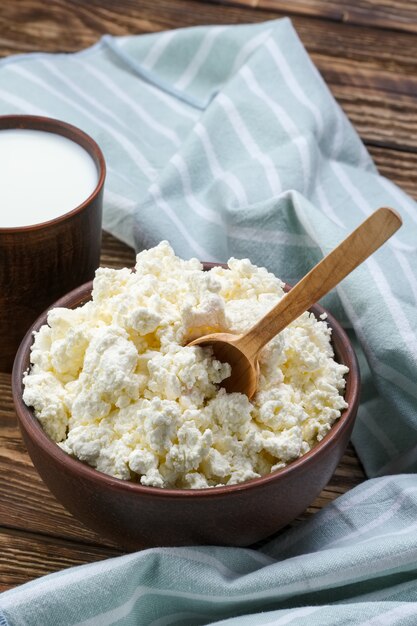
A mother can feed her child with homemade cottage cheese and those sold in the store. Each product has its pros and cons.
When can a child be given regular cottage cheese? It is better to postpone its introduction until the transition from complementary foods to the general table. It is right to start fermented milk complementary foods with industrial-made cottage cheese, designed specifically for baby food. So the mother will spend less time in the kitchen, and the baby will receive a product balanced in nutrients and pleasant in texture.
Cottage cheese is a healthy product with high nutritional value, which must be present in the diet of a baby in the second half of life. But it is important to use a product suitable for the baby. Ready-made children's cottage cheese is varied in taste. And this makes it easier to accustom the child to solid food, allows you to maintain interest in food, expand the diet. In addition to the traditional cow's milk curd, you can try fruit purees with goat's curd for babies from 6 months from the MAMAKO 9 assortment0086® . Soft creamy goat curd and healthy children and toddlers who have digestive problems. Try it and see for yourself - even little kids will love it!
Soft creamy goat curd and healthy children and toddlers who have digestive problems. Try it and see for yourself - even little kids will love it!
* Breast milk is the best food for babies. WHO recommends exclusive breastfeeding for the first 6 months of a child's life and continued breastfeeding after complementary foods are introduced until the age of 2 years. Before introducing new products into the baby's diet, you should consult with a specialist. The material is for informational purposes and cannot replace the advice of a healthcare professional. For feeding children from birth.
Information sources
one.
Innovations in baby food. Edited by V.A. Tuteliana, MIA, 2020
2.
The program for optimizing the feeding of children in the first year of life in the Russian Federation, Moscow, 2019
3.
T. I. Legonkova, K. S.




